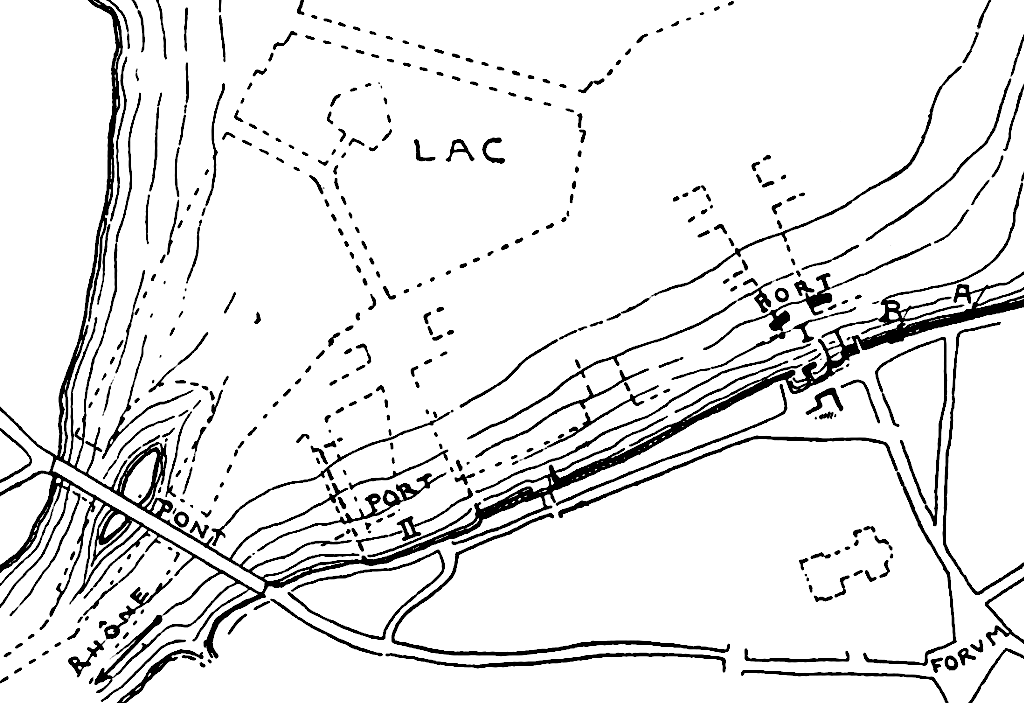|
Introduction The first to third century The harbours Late antiquity Christianity |
In the first decades of the 20th century remains of two harbours were found on the Lac Léman. The remains lay beneath the current city, in the area of the Rue d'Enfer and the Rue de la Fontaine, because the shore of the lake has moved since Roman times. There was a quay of enormous blocks along the shore.

Plan with the two harbours on the lake. Blondel 1925, fig. 4.
The river Rhône flows through the lake. It has been suggested that one of the harbours, near the place where the river leaves the lake, was used by skippers on the river. They are documented in an inscription that was found in 1678 in the Rhône: ratiarii superiores, "raftsmen of the upper course (of the Rhône)", the stretch between Genève and Lyon in France. The other harbour would then have been used by the nautae Lacus Lemanni, "skippers of Lac Léman". These are documented in an inscription that had been reused as building material and was discovered in 1925. It was erected by the skippers in honour of an official (quattuorvir) from Vienne, France. In the harbour area may also have been the customs office, the statio of the quadragesima Galliarum, the "Fortieth of the Gauls". It is documented in a funerary inscription found in 1917.
DEO SILVA
NO PRO SALV
[t]E RATIARIOR(um)
SVPERIOR(um) A
MICOR(um) SVOR(um)
POS(u)it L(ucius) SANCT(ius)
MARCVS CIVIS HEL(vetius)
V(otum) S(olvit) L(ibens) M(erito)
D[e] SVO D(edit)To the god Silvanus,
for the well-being
of the raftsmen
of the upper course,
his friends.
Placed by Lucius Sanctius
Marcus, Helvetic citizen.
He fulfilled his vow gladly, deservedly.
He donated at own expense.Altar of limestone. H. 0.95.
Photo: EDCS-09201049.
Q(uinto) DECIO ALPINO
IIIIVIR(o)
NAVTAE LACVS
LEMANNIFor Quintus Decius Alpinus,
quattuorvir.
The skippers of Lake
Léman.Statue base of limestone.
W. 0.71, h. 1.12, d. 0.62.
EDCS-13302020.
Photo: Musée d'art et d'histoire, Genève.
D(is) M(anibus)
AVR(elio) VALENTI
AVG(usti) LIB(erto) P(rae)P(osito) XL
GALL(iarum) STAT(ionis) GEN(avensis)
AVR(elius) EVTYCHES
LIB(ertus) ET EVE[ntius(?)]
HERE[des fac(iendum) cur(averunt)]To the spirits of the underworld.
For Aurelius Valens,
Imperial freedman, head of the 40th
of the Gauls of the office in Geneva.
Aurelius Eutyches,
freedman, and Eventius,
his heirs, took care of the work.Funerary altar of limestone.
W. 0.47, h. 0.65, d. 0.33.
EDCS-16201642.
Photo: Musée d'art et d'histoire, Genève.
Introduction
The first to third century
The harbours
Late antiquity
Christianity
[17-Feb-2024]